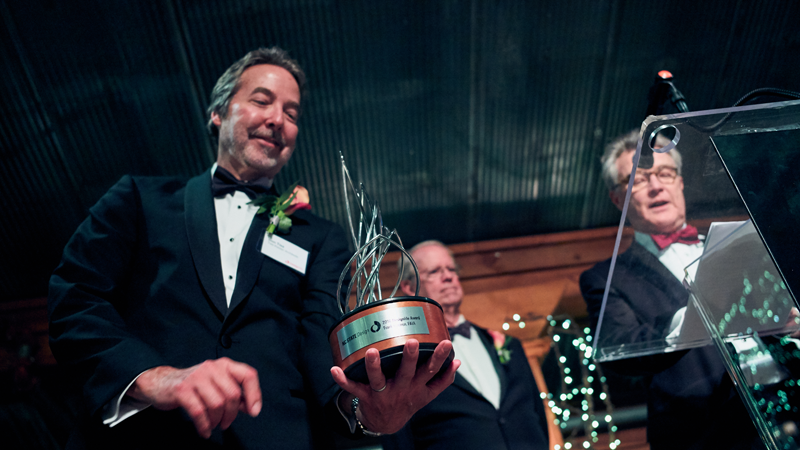Honoring the Spirit of Design

Every year, the College of Design honors someone who has made an impact on design in the Southeast with the Designlife Award (formerly the Design Guild Award). From its inception, it has symbolized how the practice good design reflects on citizenship. The original award, designed by Dean Emeritus Marvin Malecha, featured a box that, when opened, revealed a figure that could be spun — symbolic of the dance of life he attributed to design.
Fast forward two decades, and a transition in leadership brought new opportunities for change. When Mark Hoversten became Dean, Director of Development and External Relations Jean Marie Livaudais approached Leaders Council members Craig McDuffie (‘83 Visual Design, President of McDuffie Design) and Matt McConnell (‘94 BEDA, ‘95 BID, owner of McConnell Studios) about how that change could be reflected in the award.
“When Dean Malecha received the Designlife Award in 2017, it seemed fitting to honor him with the last of that design, which meant coming up with a fresh idea,” McDuffie explained. He and McConnell were delighted to be involved, and, seeing a need for diverse perspectives in the process, invited Kimberly Siran (‘97 MLA, owner of Coaly Design) to the team.
Drawing upon their experiences as students at the College, they went through the design process, examining the whys behind the redesign and the definition of design itself. “We decided the award should symbolize community – who we deal with as designers, as well as who and what we represent with the award,” said McDuffie. “Loosely representing design instead of one specific discipline was important.”
But how to express that in a single piece?
“We wanted to reflect the action of the previous design,” said McConnell. “Simultaneously, we were talking about the spirit of what it represents.”
McConnell, who owns a studio in Raleigh and has worked on installations and sculptures around the world, saw the project as a perfect opportunity to home in on the concepts of community and growth. The team discussed several ideas before settling on a final concept: an unfolding array, a rising spire of leaves — McConnell hesitated to put a descriptor on it, because his work is often abstract.
“It’s a little moving, functioning object,” was his initial assessment. “The technological nature of it became industrial design. It has a leafy shape, representing landscape [architecture]. It looks like a tower, and if you scaled it up, it could be architecture. There’s the obvious art part, where it’s a sculpture on its own. And it’s got this bold, graphic form to represent graphic design. We had all the disciplines and were well represented within our group, too.”
Because the Designlife Award is a reflection of the College of Design community, Livaudais stressed the importance that it be connected to the College and have the Materials Lab’s involvement in crafting it. McConnell was thrilled to take the award to Jim Dean, David Knight, and Rob Watson for collaboration. He credits Dean with the idea to use magnets to hold the system of the award’s moving parts together, and with the idea to create a wood wrap for the base.
Like students in a studio, the team worked under a deadline to produce the final product. The approach was one of uniqueness based on the recipient. “It can be left in various states, so that the person who receives the award can live with it aligned or not,” McConnell explained.
Professor of Practice Frank Harmon, FAIA, was the first to receive the “new” Designlife Award on April 21, 2018. Before the Designlife Award Gala, the team pondered what other distinctions they could give to the award to tie it back to Harmon.
“We talked about his architecture and his style,” said McDuffie. “That’s where the wood wrap came from. It’s simple, but it’s still a nod in his direction. Who knows in the future what it might be?”
McDuffie reflected on the dance of life as he compared the redesign with the original. “It wasn’t a static thing. It wasn’t just a plaque with the name of the school on it. When we went into this process, we had to keep that idea. There had to be a story about what this represents. And it had to be changeable, because design is always changing.”
Even in post-production, the team still riffed on ideas for how it might change for the next recipient. “Maybe the finish could change?” McConnell mused. “Or it could be the color. That’s the thing. I have my way, and it informed where this landed. I’m honored that the character of what I do found its way in here. But it’s not so it can speak to the artists that worked on it. It’s about a whole lot more.”


